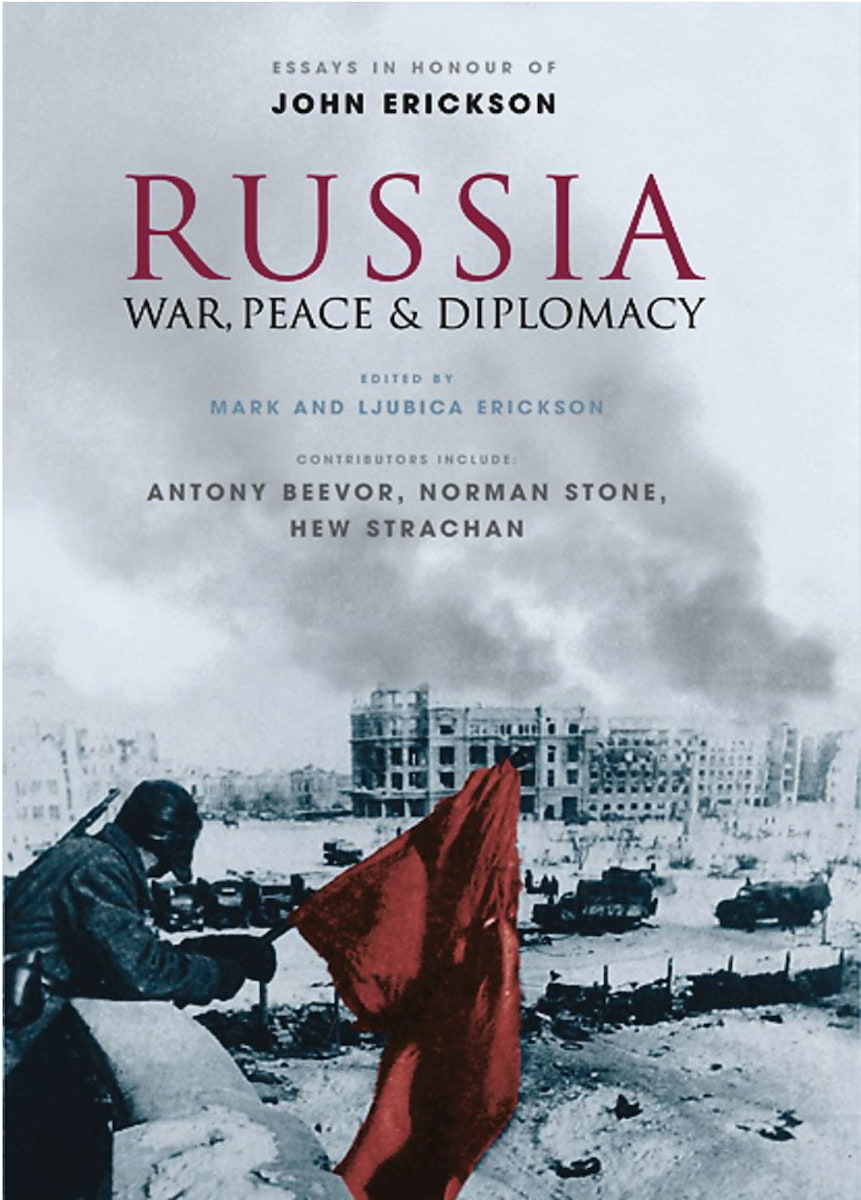
Ed. Mark and Ljubica Erickson
“Women and the Battle of Stalingrad,” in
Russia: War, Peace and Diplomacy – Essays in Honour of John Erickson
Publisher: Weidenfeld & Nicolson
ISBN: 978-0297849131
Publication date: 2005
For many readers John Erickson opened up the history of Russia with his classic book THE ROAD TO STALINGRAD. The drama and scale of Russia’s history makes it perennially popular and many of today’s best-known historians write about or specialise in it – including Norman Stone, Robert Service and Antony Beevor. They have all contributed to this book, together with other leading historians, in honour of John Erickson. As a result this is a distinguished collection of great variety; from David Glantz exploring forgotten battles with Germany, to Reina Pennington on the women who took part in the Battle of Stalingrad, Antony Beevor explaining how he uncovered the realities of the seige, and James Cant on the controversy of Russian nuclear missiles trained on Europe. The foreword was written by Sir Michael Howard.
CONTENTS: 1. Cock of the East: a Gordon Blade abroad / Dmitry Fedosov 2. Jomini versus Clausewitz / A.N. Mertsalov 3. ‘Catastrophes to come …’: Russian and Soviet visions of future war, 1866 to the present / Christopher Bellamy 4. Russia, Germany and Anglo-Japanese intelligence collaboration, 1898-1906 / John W.M. Chapman 5. Britain and Russia, 1914-1917 / Hew Strachan 6. Military policy, international relations and Soviet security after October 1917 / Robert Service 7. Turkey in the Russian mirror / Norman Stone 8. The ideology and realities of Soviet women’s tractor driving in the 1930s / Mary Buckley 9. The German military’s image of Russia / Jürgen Förster 10. Celluloid soldiers: cinematic images of the Wehrmacht / Omer Bartov 11. The devil his due: American views of the Soviet Union before and after Barbarossa / Roger Beaumont 12. Stalingrad and researching the experience of war / Antony Beevor 13. Women and the battle of Stalingrad / Reina Pennington 14. Forgotten battles of the Soviet-German War, 1941-45 / David M. Glantz 15. Ordinary collaborators: the case of the Travniki guards / Sergei Kudryashov 16. The SS-20 missile – why were you pointing at me? / James Cant 17. Cold Wars new and old: post-Cold War perspectives on the Washington Conference, 1921-1922 / Paul Dukes 18. The new Central Asia: challenges for the region / Sally N. Cummings 19. Rumours as evidence / Donald Cameron Watt 20. The Edinburgh conversations / Lynn Hansen.
from Reina Pennington’s essay on “Women and the Battle of Stalingrad”
“We must broaden over views about the battle of Stalingrad; it was not an all-male event, as it is stereotypically depicted. Thousands of women—military and civilian, combatant and noncombatant—participated in the battle from start to finish, day in and day out. In his 1959 book, Marshal Chuikov made the following statement about women and the battle of Stalingrad:
Remembering the defense of Stalingrad, I can’t overlook one very important question which, in my opinion, is still weakly covered in military literature, and at times unjustifiably forgotten in our reports and work on the generalization of the experience of the Great Patriotic War. I have in mind the question about the role of women in war, in the rear but also at the front. Equally with men they bore all the burdens of combat life and together with us men, they went all the way to Berlin.
“Unfortunately, sixty years after the end of the battle and forty-four years after Chuikov’s book appeared, women’s roles are still overlooked. The recent movie “Enemy at the Gates” deliberately downplayed the role of women at Stalingrad; although it showed a number of women in uniform, none of them, not even the so-called snipers, ever killed an enemy; they were more often seen putting on makeup or panicking under attack. Such an image hardly seems consistent with reality. Whatever their roles, the women who participated at Stalingrad are described as soldiers (boets or voin). They regarded themselves as soldiers; A. Vasilenko, who served in the Red Army at Stalingrad in an unknown capacity, signed a letter to her mother “with the warmest greetings of a Red Army fighter.” This essay is only a preliminary investigation into this historical event, but it shows how much information can be obtained from published sources. Much more work remains to be done in the archives. We will not truly understand the complexity of such an important historical event as the battle of Stalingrad until we learn more about the participation of women and the ways in which the Red Army military experience varied from anything known in the West.”
“
“Reina Pennington’s “Women and the Battle of Stalingrad” offers an exhaustive account of women fighting and dying in the great slaughterhouse on the Volga. . . . one is left breathless with the amazing courage, fortitude and strength of Russian women during one of history’s most hellish battles.”
